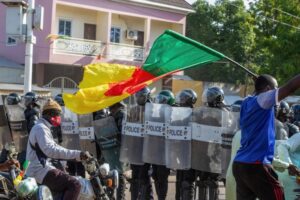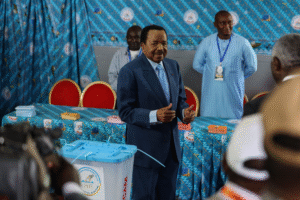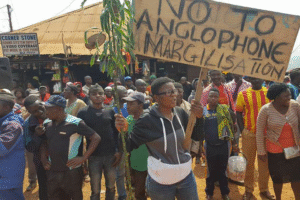I’m writing as someone who has lived the story we too often file under a tidy word: migration. But there is a difference between choosing to move and being pushed out by violence, state repression, or fear. While both involve a decision about whether to stay or go, one is deliberate and planned; the other is sudden and forced. That difference matters right now because it has been just a month since the United States ended Temporary Protected Status (TPS) for Cameroonians, effective August 4, 2025—a decision published in the Federal Register and confirmed by USCIS notices.
For those who may not know this small country on the Gulf of Guinea and the nearly decade-old socio-political crisis it faces, let me explain. Cameroon’s current turmoil began in late 2016, when lawyers and teachers in the Anglophone regions protested government marginalization. What began as peaceful demonstrations was met with violent crackdowns. By 2017, armed separatist groups had formed, government forces retaliated, and the conflict escalated into what is now known as the Anglophone Crisis. Since then, villages have been burned, schools attacked, and more than one million Cameroonians displaced inside the country, with hundreds of thousands more fleeing across borders.
So why should the United States care? Honestly, it doesn’t have to. In terms of international law, the U.S. has no binding obligation to shelter Cameroonians through TPS. But when Congress created the program in the Immigration Act of 1990, it wasn’t just a bureaucratic tool, it was a commitment. TPS was designed for exactly the kind of instability Cameroonians face today. It is not a loophole, nor a hidden pathway to a green card. It is a humanitarian pause button. It signals a simple principle: we will not force people to return to a country in the middle of a crisis.
The Department of Homeland Security recognized this in 2023, when it extended Cameroon’s TPS designation through June 7, 2025, citing ongoing armed conflict and extraordinary humanitarian need. Yet in June 2025, DHS announced in the Federal Register that it would terminate TPS for Cameroon, effective August 4, giving only a 60-day wind-down. Overnight, thousands of people lost the ability to work lawfully, renew a driver’s license, or live without fear of deportation. If the policy goal is “order,” then ending TPS this way has chosen chaos instead. It pushes people who were visible; working, paying taxes, raising families, back into the shadows, where exploitation is easier and community ties are harder to sustain.
The timing couldn’t have been worse. Cameroon’s Anglophone regions have endured an armed conflict since 2017; bombings and ambushes are still occurring. On September 7, a separatist roadside attack killed seven soldiers in the Southwest. One of many reminders that violence has not ended simply because the calendar has turned. Elections often spike risk, and this year’s presidential vote is set for October 12, 2025. The humanitarian toll is staggering. Cameroon hosts more than 1.5 million people forcibly displaced: over one million internally displaced, plus hundreds of thousands of refugees and asylum seekers. It’s worthy to note there is no plan of integration or reintegration by the Cameroonian government. In the North-West and South-West regions alone, OCHA counted hundreds of thousands of IDPs this spring. So why punish those who managed to flee? Why strip protection from Cameroonians in the U.S. while their compatriots remain trapped in humanitarian marginalization, even in the capital city?
Here’s the practical fallout of ending TPS without a bridge:
- Legal limbo. People who’ve been working, paying taxes, and building community lose work authorization. Many will not “self-deport” into an active conflict; they will be pushed into the shadows, easier to exploit.
- Return risk is real. People are not repatriated to a stable arena; we are funneling them back during an election season that historically invites intimidation and violence, layered onto a long-running insurgency.
- De facto statelessness. TPS holders do not lose their Cameroonian nationality on paper. But when you cannot safely return and you are stripped of lawful presence and work here, you are functionally without a state’s protection. That is a policy-made vulnerability, not a natural disaster.
I know someone will say, “But TPS is temporary.” True! The “T” has never been in dispute. The real question is whether ending it now, in the middle of mass displacement, on the eve of an election could inflame tensions, and while armed conflict is still ongoing aligns with U.S. interests or values. If the goal is deterrence, this is a blunt instrument aimed at the wrong target. People fleeing violence don’t run cost-benefit analyses; they run.
So let’s bring back the ladder for people who have been forced to run. The humanitarian crisis in Cameroon is not over, it is ongoing, even if it has slipped from headlines. TPS was meant to be that ladder: a temporary refuge that recognizes danger and refuses to push people back into it. Removing it now doesn’t restore order; it pulls the ladder away while people are still climbing.
If you want to understand what this crisis feels like on the ground, listen directly to those living it. On my website, MukumSteven.com, you can watch interviews with internally displaced women from Cameroon who share the daily pain of being unable to return home.
You can also learn more about the community-based organizations doing the hard work of relief and rehabilitation:
- HARO (Hope and Rehabilitation Organization), which provides humanitarian aid, trauma support, and livelihood assistance (harocameroon.org)
- LODGE IDPs, an association supporting displaced families in Cameroon (Facebook page)




